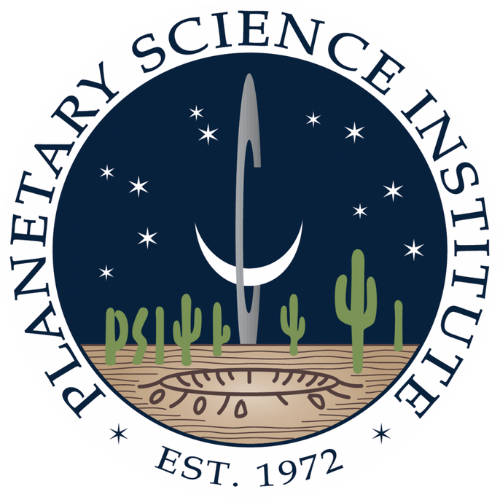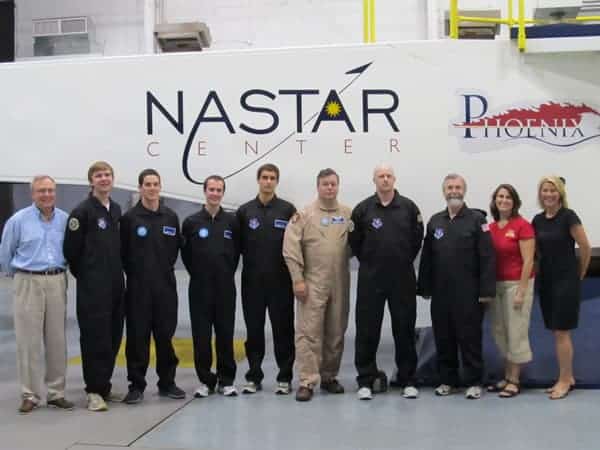Members of the Planetary Science Institute’s Atsa Suborbital Observatory project participated in a suborbital scientist training course at the NASTAR Center in Southampton, Penn.
Pictured here, left to right, are Gregory Kennedy (NASTAR), Andrew Strasburger (Wofford College), Daniel Pittman (The Citadel), Ryan Boodee (The Citadel), Daniel Showers (Clemson University), Luke Sollitt (The Citadel), Brent Garry (PSI), Mark Sykes (PSI), Melissa Lane (PSI) and Brienna Henwood (NASTAR).
PSI scientists and undergraduate students from The Citadel and other South Carolina colleges received training in support of PSI’s human-tended Atsa Suborbital Observatory at the National AeroSpace Training and Research (NASTAR) Center in Southampton, Penn.
The Atsa project will use a reusable suborbital spacecraft equipped with a specially designed telescope to provide low-cost space-based observations above the contaminating atmosphere of Earth, while avoiding some operational constraints of satellite telescope systems.
The three-day NASTAR Suborbital Scientist course equips individuals with hands-on knowledge and skills to safely cope with the rigors of suborbital spaceflight and gives an understanding of the challenges involved with conducting experiments in space. The course includes four core elements: Altitude Physiology, G-Tolerance, Space Launch and Reentry Training, and Distraction Management.
High-altitude physiology training enables trainees to experience the effects of hypoxia or oxygen-deprivation firsthand with an altitude chamber flight to 25,000 feet. Trainees also learn safety protocols and considerations in a loss of cabin pressure event.
G-tolerance flights introduce trainees to the physiological and physiological acceleration effects of spaceflight and teach ways to mitigate the symptoms of gravity-induced loss of consciousness (G-LOC). Simulated space flights are conducted on the NASTAR Phoenix STS-400 centrifuge where trainees learn to handle the maximum acceleration G loads encountered during launch and reentry up to three and one half times Earth’s gravity oriented up-and-down (eyeballs-down) and six times Earth’s gravity oriented front-to-back (eyeballs-in).
This is the first NASTAR suborbital science class dedicated to a single project or program. The NASTAR training included simulated spaceflights in a centrifuge. Team members flew profiles for Virgin Galactic’s SpaceShip2 and a vehicle approximating XCOR’s Lynx. PSI and XCOR Aerospace recently signed a Memorandum of Understanding laying the groundwork for flying Atsa on their Lynx spacecraft.
PSI Senior Scientist Faith Vilas and PSI Affiliate Scientist Luke Sollitt, who is an Assistant Professor at The Citadel, are the inventors of Atsa and were present, overseeing the training and collecting information to be used in designing training activities for Atsa operators.
“NASTAR is providing essential input for designing the training regimen we will require for Atsa operators,” said Vilas.
“Because this is a human-tended observatory, we need to understand in more than a theoretical way how the operator will be affected by the launch environment,” said Sollitt. “This will also impact the design of the interfaces and the instrument itself.”
Atsa telescope operations will commence immediately after the spacecraft’s main engine cutoff. Those participating in the flight simulations conducted a number of exercises to understand how performance would be affected by recently experienced G-forces.
Also participating from PSI were Research Scientist Brent Garry, CEO and Director Mark Sykes, and Senior Scientist Melissa Lane. The undergraduate students are participating in the South Carolina Space Grant consortium’s Palmetto Academy program under the supervision of Professor Sollitt and are involved in the design and construction of the Atsa Mark 1. These students included Andrew Strasburger from Wofford College, Daniel Showers from Clemson University, and Ryan Boodee and Daniel Pittman from The Citadel.
“The Atsa team are driven to establish the first human-tended observatory in space using suborbital vehicles,” said Brienna Henwood, Director of Space Training and Research Programs at the NASTAR Center. “It was a pleasure to work with the Atsa team in designing tangible research activities and simulated spaceflight missions that will enable them know what to expect in flight and plan their space mission accordingly. NASTAR Center looks forward to a long-term relationship with PSI and the Atsa team as their project develops further. “
Contact
Faith Vilas
Atsa Project Scientist, PSI Senior Scientist
281-851-8947
[email protected]

